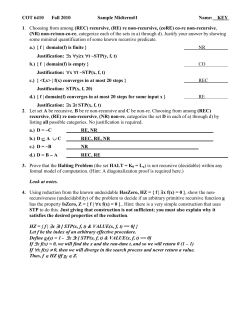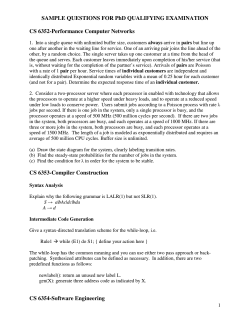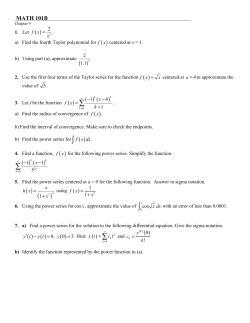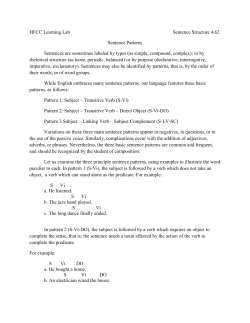
y = . z =
COT 6410
Spring 2014
Final Exam E1 Sample
Name:
• The notation z = <x,y> denotes the pairing function with inverses x = <z>1 and y = <z>2.
• The minimization notation µ y [P(…,y)] means the least y (starting at 0) such that P(…,y) is true.
The bounded minimization (acceptable in primitive recursive functions) notation
µ y (u≤y≤v) [P(…,y)] means the least y (starting at u and ending at v) such that P(…,y) is true. I
define µ y (u≤y≤v) [P(…,y)] to be v+1, when no y satisfies this bounded minimization.
• The tilde symbol, ~, means the complement. Thus, set ~S is the set complement of set S, and the
predicate ~P(x) is the logical complement of predicate P(x).
• A function P is a predicate if it is a logical function that returns either 1 (true) or 0 (false). Thus,
P(x) means P evaluates to true on x, but we can also take advantage of the fact that true is 1 and
false is 0 in formulas like y × P(x), which would evaluate to either y (if P(x)) or 0 (if ~P(x)).
• A set S is recursive if S has a total recursive characteristic function χ S, such that x ∈ S ⇔ χ S(x).
Note χ S is a total predicate. Thus, it evaluates to 0 (false), if x ∉ S.
• When I say a set S is re, unless I explicitly say otherwise, you may assume any of the following
equivalent characterizations:
1. S is either empty or the range of a total recursive function fS.
2. S is the domain of a partial recursive function gS.
• If I say a function g is partially computable, then there is an index g (we tend to overload the index
as the function name), such that Φ g(x) = Φ(x, g) = g(x). Here Φ is a universal partially recursive
function.
Moreover, there is a primitive recursive function STP, such that
STP(g, x, t) is 1 (true), just in case g, started on x, halts in t or fewer steps.
STP(g, x, t) is 0 (false), otherwise.
Finally, there is another primitive recursive function VALUE, such that
VALUE(g, x, t) is g(x), whenever STP(g, x, t).
VALUE(g, x, t) is defined but meaningless if ~STP(g, x, t).
• The notation f(x)↓ means that f converges when computing with input x (x ∈ Dom(f)). The notation
f(x)↑ means f diverges when computing with input x (x ∉ Dom(f)).
• The Halting Problem for any effective computational system is the problem to determine of an
arbitrary effective procedure f and input x, whether or not f(x)↓. The set of all such pairs, K0, is a
classic re non-recursive set. K0 is also known as Lu, the universal language. The related set, K, is the
set of all effective procedures f such that f(f)↓ or more precisely Φ f(f).
• The Uniform Halting Problem is the problem to determine of an arbitrary effective procedure f,
whether or not f is an algorithm (halts on all input). This set, TOTAL, is a classic non re set.
• When I ask for a reduction of one set of indices to another, the formal rule is that you must produce a
function that takes an index of one function and produces the index of another having whatever
property you require. However, I allow some laxness here. You can start with a function, given its
index, and produce another function, knowing it will have a computable index. For example, given f,
a unary function, I might define Gf, another unary function, by
Gf(0) = f(0); Gf(y+1) = Gf(y) + f(y+1)
This would get Gf(x) as the sum of the values of f(0)+f(1)+…+f(x).
•
The Post Correspondence Problem (PCP) is known to be undecidable. This problem is
characterized by instances that are described by a number n>0 and two n-ary sequences of nonempty words <x1,x2,…,xn>, <y1,y2,…,yn>. The question is whether or not there exists a sequence,
i1,i2,…,ik, such that 1≤ij≤n, 1≤j≤k, and xi1xi2…xik = yi1yi2…yik
COT6410
•
– ii –
Final Exam E1 Sample – Hughes
When I ask you to show one set of indices, A, is many-one reducible to another, B, denoted
A ≤m B, you must demonstrate a total computable function f, such that x ∈ A ⇔ f(x) ∈ B. The
stronger relationship is that A and B are many-one equivalent, A ≡m B, requires that you show
A ≤m B and B ≤m A. The related notion of one-one reducibility and equivalence require that the
reducing function, f above, be 1-1. The notation just replaces the m with a 1, as in A ≤1 B.
COT 6410
Spring2014
Final Exam Sample E1 Questions
1. Let set A be recursive, B be re non-recursive and C be non-re. Choosing from among (REC)
recursive, (RE) re non-recursive, (NR) non-re, categorize the set D in each of a) through d) by
listing all possible categories. No justification is required.
a.) D = ~C
b.) D ⊆ (A∪C)
c.) D = ~B
d.) D = B − A
2. Choosing from among (D) decidable, (U) undecidable, (?) unknown, categorize each of the
following decision problems. No proofs are required.
Problem / Language Class
Regular
Context Free
Context Sensitive
L = Σ* ?
L=φ ?
L = L2 ?
x ∈ L2, for arbitrary x ?
3. Use PCP to show the undecidability of the problem to determine if the intersection of two context
free languages is non-empty. That is, show how to create two grammars GA and GB based on some
instance P = <<x1,x2,…,xn>, <y1,y2,…,yn>> of PCP, such that L(GA) ∩ L(GB) ≠ φ iff P has a
solution. Assume that P is over the alphabet Σ. You should discuss what languages your grammars
produce and why this is relevant, but no formal proof is required.
COT 6410
– 2–
Spring 2014: Final E1 Sample – Hughes
4. Consider the set of indices CONSTANT = { f | ∃K ∀y [ ϕ f(y) = K ] }. Use Rice’s Theorem to show
that CONSTANT is not recursive. Hint: There are two properties that must be demonstrated.
5. Show that CONSTANT ≡ m TOT, where TOT = { f | ∀y ϕ f(y)↓ }.
COT 6410
– 3–
Spring 2014: Final E1 Sample – Hughes
6. Why does Rice’s Theorem have nothing to say about the following? Explain by showing some
condition of Rice’s Theorem that is not met by the stated property.
AT-LEAST-LINEAR = { f | ∀y ϕ f(y) converges in no fewer than y steps }.
7. The trace language of a computational device like a Turing Machine is a language of the form
Trace = { C1#C2# … Cn# | Ci ⇒ Ci+1, 1 ≤ i < n }
Trace is Context Sensitive, non-Context Free. Actually, a trace language typically has every other
configuration word reversed, but the concept is the same. Oddly, the complement of such a trace is
Context Free. Explain what makes its complement a CFL. In other words, describe the
characteristics of this complement and why these characteristics are amenable to a CFG description.
8. We demonstrated a proof that the context sensitive languages are not closed under homomorphism,
To start, we assumed G = (N, Σ, S, P) is an arbitrary Phrase Structured Grammar, with N its set of
non-terminals, Σ its terminal alphabet, S its starting non-terminal and P its productions (rules). Since
G is a PSG, it can have length increasing, length preserving and length decreasing rules. We wished
to convert G to a CSG, G’ = (N’, Σ’, S’, P’) where there are no rules that are length decreasing
(since a CSG cannot have these). We developed a way to pad the length decreasing rules from G and
then a homomorphism that gets rid of these padding characters. Define G’ and the homomorphism h
that we discussed in class and then briefly discuss why this new grammar and homomorphism
combine so h(L(G’)) = L(G), thereby showing that all re sets are the homomorphic images of CSLs.
© Copyright 2025





















